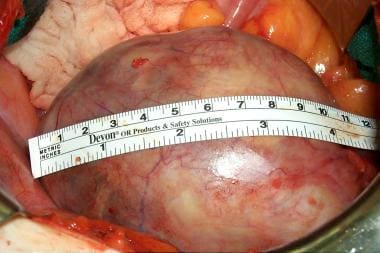Atwi D, Kamal M, Quinton M, Hassell LA. Malignant transformation of mature cystic teratoma of the ovary. J Obstet Gynaecol Res. 2022 Dec. 48 (12):3068-3076. [QxMD MEDLINE Link].
Ahmed A, Lotfollahzadeh S. Cystic Teratoma. 2023 Jan. [QxMD MEDLINE Link]. [Full Text].
Makin EC, Hyett J, Ade-Ajayi N, Patel S, Nicolaides K, Davenport M. Outcome of antenatally diagnosed sacrococcygeal teratomas: single-center experience (1993-2004). J Pediatr Surg. 2006 Feb. 41(2):388-93. [QxMD MEDLINE Link].
Pantoja E, Noy MA, Axtmayer RW, Colon FE, Pelegrina I. Ovarian dermoids and their complications. Comprehensive historical review. Obstet Gynecol Surv. 1975 Jan. 30(1):1-20. [QxMD MEDLINE Link].
Comerci JT Jr, Licciardi F, Bergh PA, Gregori C, Breen JL. Mature cystic teratoma: a clinicopathologic evaluation of 517 cases and review of the literature. Obstet Gynecol. 1994 Jul. 84(1):22-8. [QxMD MEDLINE Link].
Kumar V, Abbas AK, Fausto N. Robbins and Cotran Pathologic Basis of Disease. Philadelphia: Elsevier Saunders; 2005. 7th ed:
Grosfeld JL, Billmire DF. Teratomas in infancy and childhood. Curr Probl Cancer. 1985 Sep. 9(9):1-53. [QxMD MEDLINE Link].
Ulbright TM. Gonadal teratomas: a review and speculation. Adv Anat Pathol. 2004 Jan. 11(1):10-23. [QxMD MEDLINE Link].
Linder D, McCaw BK, Hecht F. Parthenogenic origin of benign ovarian teratomas. N Engl J Med. 1975 Jan 9. 292(2):63-6. [QxMD MEDLINE Link].
Schropp KP, Lobe TE, Rao B, et al. Sacrococcygeal teratoma: the experience of four decades. J Pediatr Surg. 1992 Aug. 27(8):1075-8; discussion 1078-9. [QxMD MEDLINE Link].
Swamy R, Embleton N, Hale J. Sacrococcygeal teratoma over two decades: birth prevalence, prenatal diagnosis and clinical outcomes. Prenat Diagn. 2008 Nov. 28(11):1048-51. [QxMD MEDLINE Link].
Hambraeus M, Arnbjörnsson E, Börjesson A, Salvesen K, Hagander L. Sacrococcygeal teratoma: A population-based study of incidence and prenatal prognostic factors. J Pediatr Surg. 2016 Mar. 51 (3):481-5. [QxMD MEDLINE Link].
Stany MP, Hamilton CA. Benign disorders of the ovary. Obstet Gynecol Clin North Am. 2008 Jun. 35(2):271-84, ix. [QxMD MEDLINE Link].
Wu RT, Torng PL, Chang DY, et al. Mature cystic teratoma of the ovary: a clinicopathologic study of 283 cases. Zhonghua Yi Xue Za Zhi (Taipei). 1996 Oct. 58(4):269-74. [QxMD MEDLINE Link].
Rushton HG, Belman AB. Testis-sparing surgery for benign lesions of the prepubertal testis. Urol Clin North Am. 1993 Feb. 20(1):27-37. [QxMD MEDLINE Link].
Ulbright TM. Germ cell neoplasms of the testis. Am J Surg Pathol. 1993 Nov. 17(11):1075-91. [QxMD MEDLINE Link].
Lewis BD, Hurt RD, Payne WS, Farrow GM, Knapp RH, Muhm JR. Benign teratomas of the mediastinum. J Thorac Cardiovasc Surg. 1983 Nov. 86(5):727-31. [QxMD MEDLINE Link].
Gumer AT, Ghanem SM. Germ Cell Tumors. Ghanem SM, Hadi N, Al-Haris N, eds. Essentials of Pediatric Surgery. Sharjah, UAE: Bentham Science Publishers Pte. Ltd.; 2020. 216-22.
Gabra HO, Jesudason EC, McDowell HP, Pizer BL, Losty PD. Sacrococcygeal teratoma--a 25-year experience in a UK regional center. J Pediatr Surg. 2006 Sep. 41(9):1513-6. [QxMD MEDLINE Link].
Ayhan A, Bukulmez O, Genc C, Karamursel BS, Ayhan A. Mature cystic teratomas of the ovary: case series from one institution over 34 years. Eur J Obstet Gynecol Reprod Biol. 2000 Feb. 88(2):153-7. [QxMD MEDLINE Link].
Carver BS, Al-Ahmadie H, Sheinfeld J. Adult and pediatric testicular teratoma. Urol Clin North Am. 2007 May. 34(2):245-51; abstract x. [QxMD MEDLINE Link].
Moran CA, Suster S. Primary germ cell tumors of the mediastinum: I. Analysis of 322 cases with special emphasis on teratomatous lesions and a proposal for histopathologic classification and clinical staging. Cancer. 1997 Aug 15. 80(4):681-90. [QxMD MEDLINE Link].
Flake AW, Harrison MR, Adzick NS, Laberge JM, Warsof SL. Fetal sacrococcygeal teratoma. J Pediatr Surg. 1986 Jul. 21(7):563-6. [QxMD MEDLINE Link].
Hedrick HL, Flake AW, Crombleholme TM, et al. Sacrococcygeal teratoma: prenatal assessment, fetal intervention, and outcome. J Pediatr Surg. 2004 Mar. 39(3):430-8; discussion 430-8. [QxMD MEDLINE Link].
Gucciardo L, Uyttebroek A, De Wever I, Renard M, Claus F, Devlieger R, et al. Prenatal assessment and management of sacrococcygeal teratoma. Prenat Diagn. 2011 Jul. 31(7):678-88. [QxMD MEDLINE Link].
Altman RP, Randolph JG, Lilly JR. Sacrococcygeal teratoma: American Academy of Pediatrics Surgical Section Survey-1973. J Pediatr Surg. 1974 Jun. 9(3):389-98. [QxMD MEDLINE Link].
Partridge EA, Canning D, Long C, Peranteau WH, Hedrick HL, Adzick NS, et al. Urologic and anorectal complications of sacrococcygeal teratomas: prenatal and postnatal predictors. J Pediatr Surg. 2014 Jan. 49(1):139-42; discussion 142-3. [QxMD MEDLINE Link].
Cozzi F, Schiavetti A, Zani A, Spagnol L, Totonelli G, Cozzi DA. The functional sequelae of sacrococcygeal teratoma: a longitudinal and cross-sectional follow-up study. J Pediatr Surg. 2008 Apr. 43(4):658-61. [QxMD MEDLINE Link].
Kremer ME, Derikx JP, van Baren R, Heij HA, Wijnen MH, Wijnen RM, et al. Patient-Reported Defecation and Micturition Problems Among Adults Treated for Sacrococcygeal Teratoma During Childhood--The Need for New Surveillance Strategies. Pediatr Blood Cancer. 2016 Apr. 63 (4):690-4. [QxMD MEDLINE Link].
Benjapibal M, Boriboonhirunsarn D, Suphanit I, Sangkarat S. Benign cystic teratoma of the ovary : a review of 608 patients. J Med Assoc Thai. 2000 Sep. 83(9):1016-20. [QxMD MEDLINE Link].
Dalmau J, Lancaster E, Martinez-Hernandez E, Rosenfeld MR, Balice-Gordon R. Clinical experience and laboratory investigations in patients with anti-NMDAR encephalitis. Lancet Neurol. 2011 Jan. 10(1):63-74. [QxMD MEDLINE Link]. [Full Text].
Buchwalter CL, Miller D, Jenison EL. Hemolytic anemia and benign pelvic tumors. A case report. J Reprod Med. 2001 Apr. 46(4):401-4. [QxMD MEDLINE Link].
Kim I, Lee JY, Kwon JH, et al. A case of autoimmune hemolytic anemia associated with an ovarian teratoma. J Korean Med Sci. 2006 Apr. 21(2):365-7. [QxMD MEDLINE Link].
Dos Santos L, Mok E, Iasonos A, et al. Squamous cell carcinoma arising in mature cystic teratoma of the ovary: a case series and review of the literature. Gynecol Oncol. 2007 May. 105(2):321-4. [QxMD MEDLINE Link].
Walsh C, Rushton HG. Diagnosis and management of teratomas and epidermoid cysts. Urol Clin North Am. 2000 Aug. 27(3):509-18. [QxMD MEDLINE Link].
Dulmet EM, Macchiarini P, Suc B, Verley JM. Germ cell tumors of the mediastinum. A 30-year experience. Cancer. 1993 Sep 15. 72(6):1894-901. [QxMD MEDLINE Link].
Hosokawa T, Sato Y, Seki T, Maebara M, Ito K, Kuribayashi S. Malignant transformation of a mature cystic teratoma of the ovary with rupture. Jpn J Radiol. 2010 Jun. 28(5):372-5. [QxMD MEDLINE Link].
Garrett JE, Cartwright PC, Snow BW, Coffin CM. Cystic testicular lesions in the pediatric population. J Urol. 2000 Mar. 163(3):928-36. [QxMD MEDLINE Link].
Herr HW, LaQuaglia MP. Management of teratoma. Urol Clin North Am. 1993 Feb. 20(1):145-52. [QxMD MEDLINE Link].
Billmire DF, Grosfeld JL. Teratomas in childhood: analysis of 142 cases. J Pediatr Surg. 1986 Jun. 21(6):548-51. [QxMD MEDLINE Link].
Patel MD, Feldstein VA, Lipson SD, Chen DC, Filly RA. Cystic teratomas of the ovary: diagnostic value of sonography. AJR Am J Roentgenol. 1998 Oct. 171(4):1061-5. [QxMD MEDLINE Link].
Varghese TK, Lau CL. The Mediastinum. Townsend CM, Beauchamp RD, Evers BM, Mattox KL, eds. Sabiston Textbook of Surgery: The Biological Basis of Modern Surgical Practice. 18. Philadelphia, PA: Saunders Elsevier; 2007. chap 58.
Choi EJ, Koo YJ, Jeon JH, Kim TJ, Lee KH, Lim KT. Clinical experience in ovarian squamous cell carcinoma arising from mature cystic teratoma: A rare entity. Obstet Gynecol Sci. 2014 Jul. 57 (4):274-80. [QxMD MEDLINE Link]. [Full Text].
Chervenak FA, Isaacson G, Touloukian R, Tortora M, Berkowitz RL, Hobbins JC. Diagnosis and management of fetal teratomas. Obstet Gynecol. 1985 Nov. 66(5):666-71. [QxMD MEDLINE Link].
Outwater EK, Siegelman ES, Hunt JL. Ovarian teratomas: tumor types and imaging characteristics. Radiographics. 2001 Mar-Apr. 21(2):475-90. [QxMD MEDLINE Link].
Mais V, Guerriero S, Ajossa S, Angiolucci M, Paoletti AM, Melis GB. Transvaginal ultrasonography in the diagnosis of cystic teratoma. Obstet Gynecol. 1995 Jan. 85(1):48-52. [QxMD MEDLINE Link].
Scoutt LM, McCarthy SM, Lange R, Bourque A, Schwartz PE. MR evaluation of clinically suspected adnexal masses. J Comput Assist Tomogr. 1994 Jul-Aug. 18(4):609-18. [QxMD MEDLINE Link].
Mitchell JR, Siegelman ES, Sundaram KM. MR Imaging of Germ Cell and Sex Cord Stromal Tumors. Magn Reson Imaging Clin N Am. 2023 Feb. 31 (1):65-78. [QxMD MEDLINE Link].
Epifanio M, Baldissera M, Esteban FG, Baldisserotto M. Mature testicular teratoma in children: multifaceted tumors on ultrasound. Urology. 2014 Jan. 83(1):195-7. [QxMD MEDLINE Link].
Duwe BV, Sterman DH, Musani AI. Tumors of the mediastinum. Chest. 2005 Oct. 128(4):2893-909. [QxMD MEDLINE Link].
Jeung MY, Gasser B, Gangi A, et al. Imaging of cystic masses of the mediastinum. Radiographics. 2002 Oct. 22 Spec No:S79-93. [QxMD MEDLINE Link].
Talerman A. Germ Cell Tumors of the Ovary. Kurman RJ, ed. Blaustein's Pathology of the Female Genital Tract. 5th ed. New York, NY: Springer-Verlag; 2002. chap 20.
Cavenaile C, Reed J, Fiorito D. Ovarian teratoma with a high level of differentiation. South Med J. 2001 May. 94(5):522-3. [QxMD MEDLINE Link].
Van Mieghem T, Al-Ibrahim A, Deprest J, Lewi L, Langer JC, Baud D, et al. Minimally invasive therapy for fetal sacrococcygeal teratoma: case series and systematic review of the literature. Ultrasound Obstet Gynecol. 2014 Jan 31. [QxMD MEDLINE Link].
Roybal JL, Moldenhauer JS, Khalek N, Bebbington MW, Johnson MP, Hedrick HL, et al. Early delivery as an alternative management strategy for selected high-risk fetal sacrococcygeal teratomas. J Pediatr Surg. 2011 Jul. 46(7):1325-32. [QxMD MEDLINE Link].
Ding Y, Yang M, Lv M, Jiang Y, Dong T, Zhao B, et al. The ex-utero intrapartum treatment (EXIT) strategy for fetal giant sacrococcygeal teratoma with cardiac insufficiency: A case report and review of the literature. Front Oncol. 2022. 12:1035058. [QxMD MEDLINE Link]. [Full Text].
Graf JL, Albanese CT. Fetal sacrococcygeal teratoma. World J Surg. 2003 Jan. 27(1):84-6. [QxMD MEDLINE Link].
[Guideline] Royal College of Obstetricians & Gynaecologists. The Management of Ovarian Cysts in Postmenopausal Women. rcog.org.uk. Available at https://www.rcog.org.uk/globalassets/documents/guidelines/green-top-guidelines/gtg_34.pdf. July 2016; Accessed: November 22, 2019.
Knaus ME, et al; Midwest Pediatric Surgery Consortium. Laparoscopy versus laparotomy for pediatric ovarian dermoids. J Pediatr Surg. 2022 Jun. 57 (6):1008-1012. [QxMD MEDLINE Link].
Koçak M, Dilbaz B, Ozturk N, et al. Laparoscopic management of ovarian dermoid cysts: a review of 47 cases. Ann Saudi Med. 2004 Sep-Oct. 24(5):357-60. [QxMD MEDLINE Link].
Laberge PY, Levesque S. Short-term morbidity and long-term recurrence rate of ovarian dermoid cysts treated by laparoscopy versus laparotomy. J Obstet Gynaecol Can. 2006 Sep. 28(9):789-93. [QxMD MEDLINE Link].
Nezhat CR, Kalyoncu S, Nezhat CH, Johnson E, Berlanda N, Nezhat F. Laparoscopic management of ovarian dermoid cysts: ten years' experience. JSLS. 1999 Jul-Sep. 3(3):179-84. [QxMD MEDLINE Link].
Templeman CL, Fallat ME, Lam AM, Perlman SE, Hertweck SP, O'Connor DM. Managing mature cystic teratomas of the ovary. Obstet Gynecol Surv. 2000 Dec. 55(12):738-45. [QxMD MEDLINE Link].
Godinjak Z, Bilalovic N, Idrizbegovic E. Laparoscopic treatment of ovarian dermoid cysts is a safe procedure. Bosn J Basic Med Sci. 2011 Nov. 11(4):245-7. [QxMD MEDLINE Link].
Ross JH, Kay R. Prepubertal testis tumors. Rev Urol. 2004 Winter. 6(1):11-8. [QxMD MEDLINE Link].
Rushton HG, Belman AB, Sesterhenn I, Patterson K, Mostofi FK. Testicular sparing surgery for prepubertal teratoma of the testis: a clinical and pathological study. J Urol. 1990 Sep. 144(3):726-30. [QxMD MEDLINE Link].
Shukla AR, Woodard C, Carr MC, Huff DS, Canning DA, Zderic SA. Experience with testis sparing surgery for testicular teratoma. J Urol. 2004 Jan. 171(1):161-3. [QxMD MEDLINE Link].









